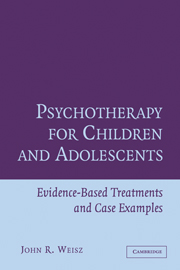Book contents
- Frontmatter
- Contents
- Preface
- SECTION A GENERAL INTRODUCTION
- SECTION B TREATMENTS FOR FEARS AND ANXIETY
- SECTION C TREATMENTS FOR DEPRESSION
- SECTION D TREATMENTS FOR ATTENTION DEFICIT/HYPERACTIVITY DISORDER
- SECTION E TREATMENTS FOR CONDUCT PROBLEMS AND CONDUCT DISORDER
- Introduction to Section E: The Case of Sal and Treatments for Conduct Problems and Conduct Disorder
- 8 Treating Conduct Problems by Teaching Anger Control
- 9 Behavioral Parent Training and Family Treatment for Conduct Problems
- 10 Parent-Child Interaction Treatments for Child Noncompliance
- 11 Parent Training through Video Modeling and Structured Group Discussion
- 12 Using Problem-Solving Skills Training and Parent Management Training for Children with Conduct Disorder
- 13 Multisystemic Therapy for Antisocial and Delinquent Youth
- SECTION F CONCLUSION
- References
- Author Index
- Subject Index
Introduction to Section E: The Case of Sal and Treatments for Conduct Problems and Conduct Disorder
Published online by Cambridge University Press: 06 July 2010
- Frontmatter
- Contents
- Preface
- SECTION A GENERAL INTRODUCTION
- SECTION B TREATMENTS FOR FEARS AND ANXIETY
- SECTION C TREATMENTS FOR DEPRESSION
- SECTION D TREATMENTS FOR ATTENTION DEFICIT/HYPERACTIVITY DISORDER
- SECTION E TREATMENTS FOR CONDUCT PROBLEMS AND CONDUCT DISORDER
- Introduction to Section E: The Case of Sal and Treatments for Conduct Problems and Conduct Disorder
- 8 Treating Conduct Problems by Teaching Anger Control
- 9 Behavioral Parent Training and Family Treatment for Conduct Problems
- 10 Parent-Child Interaction Treatments for Child Noncompliance
- 11 Parent Training through Video Modeling and Structured Group Discussion
- 12 Using Problem-Solving Skills Training and Parent Management Training for Children with Conduct Disorder
- 13 Multisystemic Therapy for Antisocial and Delinquent Youth
- SECTION F CONCLUSION
- References
- Author Index
- Subject Index
Summary
Sal
Sal, age 13, has a reputation to protect – his own, as a bad dude. He gets in trouble at school almost every week, sometimes for disobeying a school rule, sometimes for blurting out provocative comments in class, and frequently for getting into shoving matches or outright fights with other kids. He has been suspended three times, once for stealing money from another child's backpack, once for hitting another child with a stick and drawing blood, and once for shouting profanity at a teacher who was disciplining him.
One of Sal's problems is his very short fuse. He is quick to take offense, quick to assume that others mean him harm, and quick to interpret ambiguous events in a negative light. Recently, when another boy accidentally collided with him on the school playground, Sal's first response was a punch in the face and a kick in the ribs when the boy fell to the ground. Understandably, most of Sal's peers at school actively avoid him, and his only “friends” are other youngsters with conduct problems like his own; two of the youth in this deviant peer group have already been arrested once, and both are suspected of being gang members.
Sal's problems at school are paralleled by disobedient, disruptive behavior at home, which dates all the way back to the preschool years. At home he is difficult to manage and full of attitude, particularly with his mother, with whom he has never developed a close relationship.
- Type
- Chapter
- Information
- Psychotherapy for Children and AdolescentsEvidence-Based Treatments and Case Examples, pp. 251 - 254Publisher: Cambridge University PressPrint publication year: 2004
- 2
- Cited by

